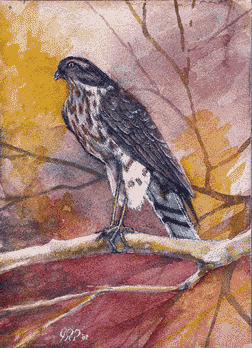 |
Earth Journal by Gary Pendleton |
The Natural Order of Backyard Birding
Short of taking down your feeders, there are few ways to keep away unwanted visitors
Here’s a trivia question for you: Name the second-fastest growing hobby in the U.S. Hint: gardening is number one, though I wonder if the popularity of video games is factored in.
The answer, however, according to the U.S. Department of Fish and Wildlife, is backyard bird feeding. If you watch the chickadees, juncos and woodpeckers outside your window, you join 65 million American backyard bird watchers.
There is no doubt in my mind that 59 million of those hobbyists have stories to tell about unwanted visitors to the feeders or that most of those stories involve an amazingly determined squirrel.
Squirrels aren’t the only notorious critters that show up uninvited at the feeder; the list includes starlings and crows, raccoons and rats. Here in the mid-Atlantic, you can add one more to the list in these cold months.
The bluejay-sized sharp-shinned hawk is the smallest of North America’s true hawks of the genus accipiter. The accipiters — including the slightly larger Cooper’s hawk — occupy wooded areas and feed largely on small birds. They have short wings and long tails, good for adroit maneuvers through dense woods chasing their winged prey. Other hawk species, like the red tailed, operate in open areas and hunt for small mammals and rodents; they have long, broad wings.
The name seems unfortunate to me. A hawk, even a small one, deserves more respect. Birds don’t even have shins, they have tarsis, which in the case of the sharp-shinned has a prominent ridge. The tarsis is analogous to the arch of the human foot. But on a bird, that piece of anatomy is long, straight and comes right up from the toes, which on birds are called the halluxes.
You can try keeping the unwanted squirrels from stealing the bird feed; believe it or not, there are methods that work fairly well. You can also limit the range of birds that you feed by using specific feeders and certain feed. There are strategies for keeping the neighbors’ cats from preying on the birds in your yard. But I don’t know how to keep out the hungry sharp-shinned hawk. My advice: Don’t try, and don’t worry about it either.
My thinking is that if you are going to feed the birds, then feed the birds and don’t exclude the birds of prey. The hawks are part of nature; they must eat other birds to survive. Besides, there is not much you can do to stop them, short of taking down all of your feeders. Consider yourself fortunate to see a sharp-shinned or Cooper’s hawk up close, right in your own back yard.




